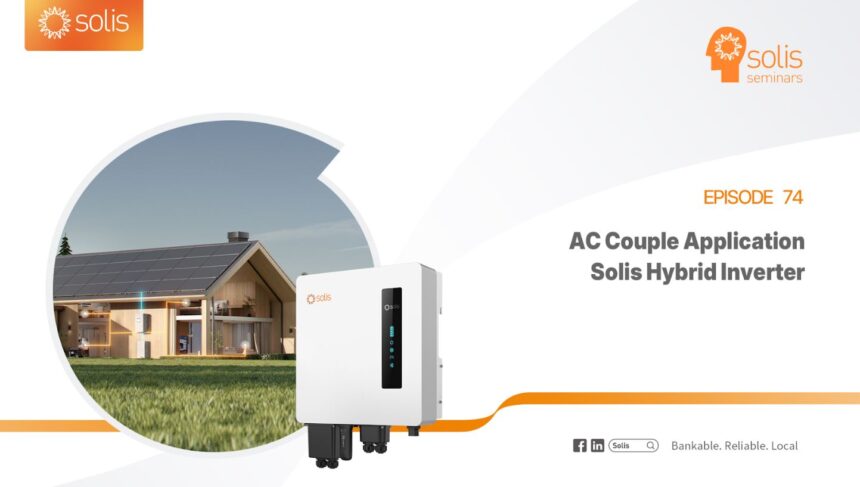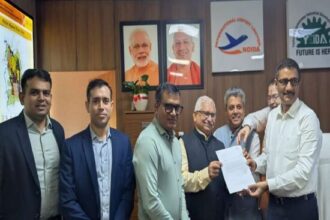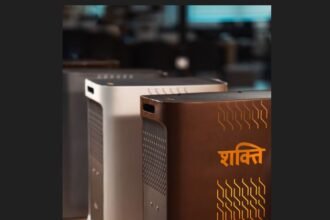Last Updated on October 2, 2025 by Author
Background
When upgrading an existing PV grid-tied system into a PV + Energy Storage system, you can add either a hybrid inverter or an AC-coupled inverter to the current setup. This forms an AC-coupled system. This guide explains the general application scenarios for AC coupling when using Solis products.
PV + Hybrid Scenario
1. Requirements of the existing PV system
- Can be a Solis PV inverter or any other brand of PV inverter.
- The AC configuration must match the Solis hybrid inverter being added:
Single-phase 230V L-N hybrid inverter works with single-phase 230V L-N PV inverter. Three-phase 400V L-L hybrid inverter works with three-phase 400V L-L PV inverter.
2. Supported Solis hybrid inverter models
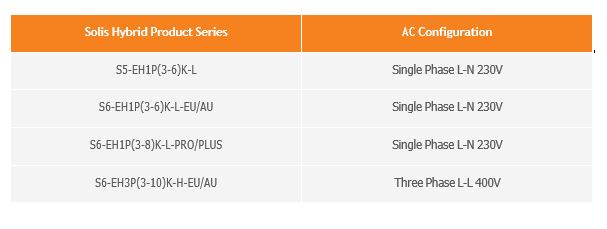
3. General Application Scenario
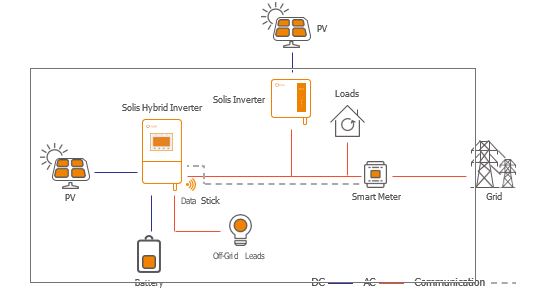
The Solis hybrid inverter dynamically charges/discharges the battery based on overall measurement data from the smart meter. It follows self-use logic while considering the operating condition of both itself and the existing PV inverter.
Note: Generation data from the existing PV inverter will not appear in the Solis monitoring system.
4. Dual Meter application scenario
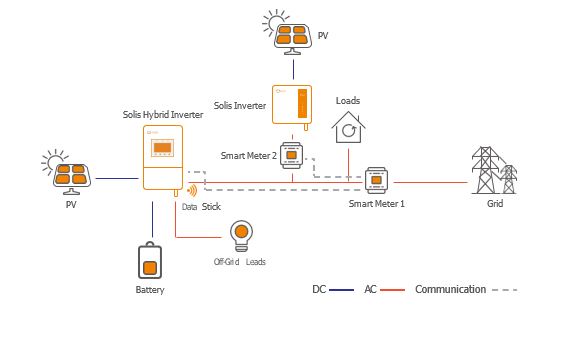
In this setup, the Solis hybrid inverter charges/discharges the battery using measurement data from Smart Meter 1, while Smart Meter 2 collects generation data from the existing PV inverter and displays it on the Solis monitoring system.
Requirements:
•Only Eastron meters are supported.
•Smart Meter 1 must be set to slave address 01 (default), and Smart Meter 2 to slave address 02. Three-phase Eastron meters can be adjusted directly via the meter LCD.
Single-phase Eastron meters may require special software and an RS485–USB adaptor to configure.
•On the Solis hybrid inverter, select “PV+Grid” in the meter installation settings.
•The Solis data logger must be updated to the latest firmware to support dual meter data.
5. Export limitation considerations
System-level export limit control is not yet available in either the general or dual meter scenario.
- Zero export (0W) is not feasible because there is no communication between the Solis hybrid inverter and the existing PV inverter. Once the battery is full, excess PV power cannot be absorbed.
- Partial export (xx W) is possible if the export limit (xx) is higher than the maximum output of the existing PV inverter. In this case, set the Solis hybrid inverter export power control to match. For example, if the PV inverter is at full generation, the Solis hybrid inverter can derate to 0W to keep the total export within the set limit.
PV + AC Couple Scenario
1. Requirements of the existing PV system
- Can be a Solis PV inverter or any other brand of PV inverter.
- The AC configuration must match the Solis AC-coupled inverter:
Single-phase 230V L-N AC-coupled inverter works with single-phase 230V L-N PV inverter.
2. Supported Solis AC Couple inverter models

3. General Application Scenario
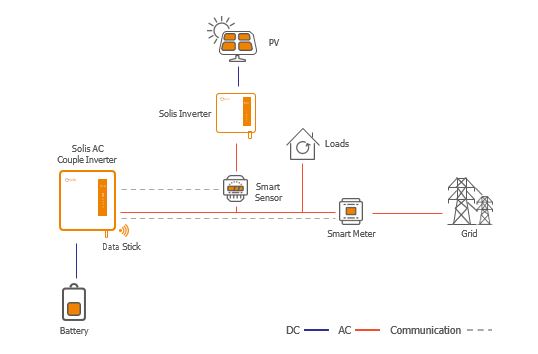
In this setup, the Solis AC-coupled inverter charges/discharges the battery based on smart meter data. A smart sensor also collects generation data from the existing PV inverter and displays it on the Solis monitoring system.
Like the PV + Hybrid scenario, system-level export limit control is not available. See Section 2.5 for details.
PV + Hybrid Scenario (Off-grid AC Couple via Frequency Control)
This scenario describes microgrid operation without any supplementary power from the public grid. Loads are supplied primarily by PV generation, and the total load capacity is determined by the backup port capacity of the hybrid inverter and PV inverter output.
When operating off-grid, the hybrid inverter establishes the reference AC voltage and frequency. If the PV inverter supports frequency-power (Freq-Watt) response, the hybrid inverter can adjust the reference frequency to control PV generation, effectively expanding off-grid PV capacity.
1. Requirements of the PV inverter
•Must support Freq-Watt response with configurable derating curve setpoints.
•The PV inverter’s max output must be smaller than the backup port rating of the Solis hybrid inverter.
•AC configuration must match (single-phase 230V L-N with single-phase, or three-phase 400V L-L with three-phase).
2. Supported Solis hybrid inverter models

3. General Application Scenario
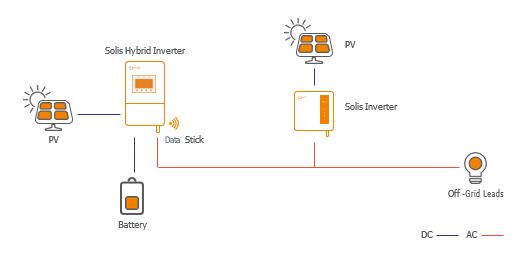
Most grid-tied PV inverters support Freq-Watt. For example, when AC frequency rises above 50.2 Hz, output power gradually reduces until it reaches 0%. When the frequency recovers, the inverter ramps back up.
Solis hybrid inverters use this by adjusting backup port frequency to control PV output. In SolisCloud, under AC Coupling settings, configure:
•AC Coupling OFF-SOC
•AC Coupling Max Frequency
When battery SOC falls 10% below the OFF-SOC setting, the hybrid inverter ramps frequency upward. This prompts the PV inverter to derate output until SOC reaches the OFF-SOC point, at which the frequency
is raised to the Max Frequency setting. This prevents excess PV generation from destabilising the off-grid system.
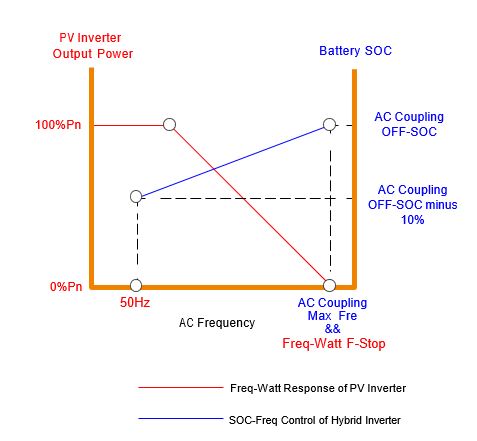
Note:
1.This scenario applies to off-grid installations, where hybrid and PV inverters do not require grid code settings. In such cases, only the configurations in Section 2 need to be completed.
2.Always confirm Freq-Watt response settings with the PV inverter manufacturer. Contact the Solis service team if you need help with Solis AC coupling setup. Solis is not responsible for damages caused by incorrect third-party PV inverter configuration.
Conclusion:
AC coupling is an important function of energy storage inverters. Solis hybrid inverters fully support this, making them a flexible option for household systems that want to expand into PV + storage applications.
Disclaimer: The information above is intended for qualified electrical professionals and trained solar installers. CT installation and inverter configuration involve working with live electrical systems. Please ensure all work is carried out safely, following local regulations and standards.





